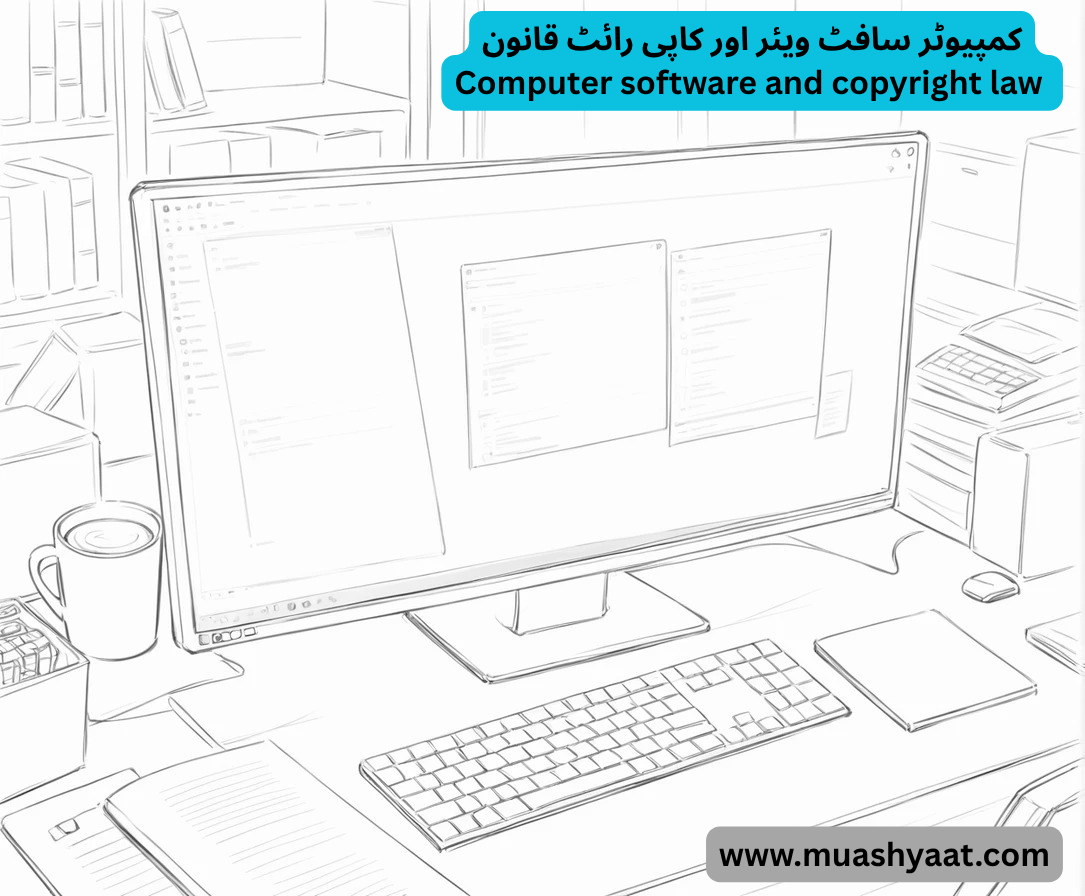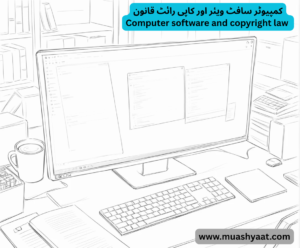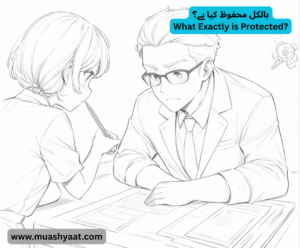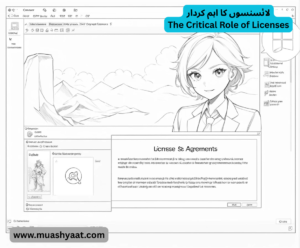کمپیوٹر سافٹ ویئر اور کاپی رائٹ قانون ⇐ یقیناً۔ یہ قانون اور ٹکنالوجی کا ایک دلچسپ اور پیچیدہ تقاطع ہے۔ یہاں کمپیوٹر سافٹ ویئر اور کاپی رائٹ قانون کی ایک جامع خرابی ہے۔
Computer software and copyright law Of course. This is a fascinating and complex intersection of law and technology. Here’s a comprehensive breakdown of computer software and copyright law.
بنیادی اصول: سافٹ ویئر بطور “ادبی کام”
بنیادی تصور یہ ہے کہ کمپیوٹر سافٹ ویئر کاپی رائٹ قانون کے ذریعے بطور ادبی کام محفوظ ہے۔ یہ باضابطہ طور پر بین الاقوامی سطح پر برن کنونشن جیسے معاہدوں اور خاص طور پر امریکہ میں 1976 کے کاپی رائٹ ایکٹ اور 1980 کے کمپیوٹر سافٹ ویئر کاپی رائٹ ایکٹ کے ذریعے قائم کیا گیا تھا۔
اس کا مطلب ہے کہ سافٹ ویئر کا اظہار — اصل کوڈ — اس لمحے سے محفوظ ہوتا ہے جب یہ “ایک ٹھوس میڈیم میں طے ہوتا ہے” (جیسے، ڈسک میں محفوظ کیا جاتا ہے)۔ تحفظ کے لیے کاپی رائٹ آفس (جیسے یو ایس کاپی رائٹ آفس) کے ساتھ رجسٹریشن ضروری نہیں ہے لیکن امریکہ میں خلاف ورزی کے لیے مقدمہ کرنا ضروری ہے اور قانونی نقصانات فراہم کرتا ہے۔
The Core Principle: Software as a “Literary Work”
- The foundational concept is that computer software is protected by copyright law as a literary work. This was formally established internationally by agreements like the Berne Convention and specifically in the U.S. by the Copyright Act of 1976 and the Computer Software Copyright Act of 1980.
- This means the expression of the software—the actual code—is protected from the moment it is “fixed in a tangible medium” (e.g., saved to a disk). Registration with a copyright office (like the U.S. Copyright Office) is not required for protection but is necessary to sue for infringement in the U.S. and provides statutory damages.
بالکل محفوظ کیا ہے؟
کاپی رائٹ خیالات، طریقہ کار، عمل، نظام، یا آپریشن کے طریقوں کی حفاظت نہیں کرتا ہے۔ یہ ان خیالات کے مخصوص اظہار کی حفاظت کرتا ہے۔ یہ سافٹ ویئر میں ایک اہم امتیاز کی طرف جاتا ہے۔
What Exactly is Protected?
- Copyright does not protect ideas, procedures, processes, systems, or methods of operation. It protects the specific expression of those ideas. This leads to a critical distinction in software.
کاپی رائٹ کیسے نافذ کیا جاتا ہے: خلاف ورزی
سافٹ ویئر کاپی رائٹ کی خلاف ورزی اس وقت ہوتی ہے جب کوئی اجازت کے بغیر کاپی رائٹ ہولڈر کے خصوصی حقوق کی خلاف ورزی کرتا ہے۔ ان حقوق میں شامل ہیں
How Copyright is Enforced: Infringement
- Software copyright infringement occurs when someone violates the exclusive rights of the copyright holder without permission. These rights include:
سافٹ ویئر کو دوبارہ پیش کرنے کا حق
مشتق کام تیار کرنے کا حق (مثلاً، موڈ، موافقت، نئے ورژن)۔
عوام میں کاپیاں تقسیم کرنے کا حق (بذریعہ فروخت، کرایہ، لیز، یا قرضہ)۔
The right to reproduce copy the software.
- The right to prepare derivative works (e.g., mods, adaptations, new versions).
- The right to distribute copies to the public (by sale, rental, lease, or lending).
خلاف ورزی کی عام مثالیں شامل ہیں
سافٹ ویئر پائریسی: تجارتی سافٹ ویئر کو غیر قانونی طور پر کاپی اور تقسیم کرنا۔
غیر تعمیل شدہ کوڈ کا استعمال: اوپن سورس پروجیکٹ سے اس کے لائسنس کی پیروی کیے بغیر سورس کوڈ کو کاپی کرنا (مثال کے طور پر، انتساب فراہم نہ کرنا یا آپ کے اخذ کردہ کام کو جی پی ایل لائسنس کی ضرورت کے مطابق اوپن سورس بنانا)۔
ادبی سرقہ: دوسرے ڈویلپر سے کوڈ کاپی کرنا اور اسے اپنے طور پر پیش کرنا۔
ایک غیر مجاز “ماخوذ کام” بنانا: جیسا کہ ترجمہ یا موافقت۔
Common examples of infringement include
- Software Piracy: Illegally copying and distributing commercial software.
- Non-Compliant Code Use: Copying source code from an open-source project without following its license (e.g., not providing attribution or making your derived work open-source as required by the GPL license).
- Plagiarism: Copying code from another developer and presenting it as your own.
- Creating an unauthorized “derivative work“: such as a translation or adaptation.
لائسنسوں کا اہم کردار
چونکہ کاپی رائٹ خودکار ہے، آپ کو کسی اور کے سافٹ ویئر کو استعمال کرنے، کاپی کرنے یا اس میں ترمیم کرنے کے لیے اجازت (لائسنس) کی ضرورت ہے۔ لائسنس صرف کاپی رائٹ کے مالک کی طرف سے آپ کو حقوق کی ایک گرانٹ ہے۔
ملکیتی لائسنس: روایتی سافٹ ویئر لائسنس (مثلاً مائیکروسافٹ ونڈوز، ایڈوب فوٹوشاپ کے لیے) جو آپ کو سافٹ ویئر کو سخت شرائط کے تحت استعمال کرنے کا حق دیتے ہیں، لیکن اس کی ملکیت، ترمیم یا دوبارہ تقسیم کرنے کا نہیں۔ وہ اکثرای یو ایل اس (اینڈ یوزر لائسنس کے معاہدے) ہوتے ہیں۔
اوپن سورس لائسنس: صارفین کو سافٹ ویئر اور اس کے سورس کوڈ کو کسی اور مقصد کے لیے استعمال کرنے، مطالعہ کرنے، تبدیل کرنے اور تقسیم کرنے کے حقوق فراہم کرتے ہیں۔ وہ ذمہ داریوں کے ساتھ آتے ہیں۔
The Critical Role of Licenses
- Since copyright is automatic, you need permission (a license) to use, copy, or modify someone else’s software. A license is simply a grant of rights from the copyright owner to you.
- Proprietary Licenses: Traditional software licenses (e.g., for Microsoft Windows, Adobe Photoshop) that grant you a right to use the software under strict conditions, but not to own, modify, or redistribute it. They are often EULAs (End User License Agreements).
- Open Source Licenses: Grant users the rights to use, study, change, and distribute the software and its source code to anyone and for any purpose. They come with obligations.
کاپی رائٹ کی حدود اور تحفظ کی دیگر اقسام
کاپی رائٹ طاقتور ہے لیکن سافٹ ویئر کی حفاظت کے لیے نامکمل ہے۔ یہی وجہ ہے کہ ڈویلپرز اور کمپنیاں قانونی ٹولز کا ایک مجموعہ استعمال کرتی ہیں۔
پیٹنٹ: ایجادات اور فعال پہلوؤں کی حفاظت کریں۔ اگر کوئی سافٹ ویئر پروگرام ایک نیا، غیر واضح، اور مفید عمل (مثلاً، ایک منفرد انکرپشن الگورتھم، ایمیزون کی “1-کلک” خریداری) کو نافذ کرتا ہے، تو یہ پیٹنٹ کے لیے اہل ہو سکتا ہے۔ پیٹنٹ کاپی رائٹ سے زیادہ مضبوط ہوتے ہیں کیونکہ وہ خیال کی حفاظت کرتے ہیں، نہ صرف اظہار، بلکہ حاصل کرنا مشکل اور مہنگا ہوتا ہے۔ سافٹ ویئر پیٹنٹ ایک متنازعہ موضوع ہے۔
ٹریڈ مارکس: سافٹ ویئر کے ماخذ کی شناخت کے لیے استعمال ہونے والے ناموں، لوگو اور نعروں کی حفاظت کریں (مثال کے طور پر، نام “ونڈوز،” ایپل لوگو، اینڈرائیڈ روبوٹ)۔ یہ صارفین کی الجھن کو روکتا ہے۔
تجارتی راز: ایسی خفیہ معلومات کی حفاظت کریں جو مسابقتی فائدہ فراہم کرتی ہے (مثلاً، الگورتھم، فارمولے، عمل)۔ سورس کوڈ کو اکثر تجارتی راز کے طور پر سمجھا جاتا ہے۔ تحفظ اس وقت تک برقرار رہتا ہے جب تک راز رکھا جاتا ہے، لیکن اگر معلومات ریورس انجنیئرڈ ہو یا پبلک ہو جائے تو وہ ضائع ہو جاتی ہے۔ نان ڈسکلوزر ایگریمنٹس (این ڈی ایز) یہاں کلیدی حیثیت رکھتے ہیں۔
The Limits of Copyright and Other Forms of Protection
- Copyright is powerful but incomplete for protecting software. This is why developers and companies use a combination of legal tools
- Patents: Protect inventions and functional aspects. If a software program implements a novel, non-obvious, and useful process (e.g., a unique encryption algorithm, Amazon’s “1-Click” purchase), it may be eligible for a patent. Patents are much stronger than copyright as they protect the idea itself, not just the expression, but are harder and more expensive to obtain. Software patents are a controversial topic.
- Trademarks: Protect names, logos, and slogans used to identify the source of the software (e.g., the name “Windows,” the Apple logo, the Android robot). This prevents consumer confusion.
- Trade Secrets: Protect confidential information that provides a competitive advantage (e.g., algorithms, formulas, processes). The source code itself is often treated as a trade secret. Protection lasts as long as the secret is kept, but is lost if the information is reverse-engineered or becomes public. Non-Disclosure Agreements (NDAs) are key here.
ہم أمید کرتے ہیں آپ کو “کمپیوٹر سافٹ ویئر اور کاپی رائٹ قانون” کے بارے میں مکمل آگاہی مل گئی ہوگی۔۔۔
MUASHYAAAT.COM 👈🏻 مزید معلومات کیلئے ہمارے اس لنک پر کلک کریں
ہماری ویب سائٹ پر آنے کیلئےشکریہ




